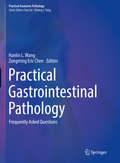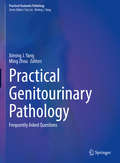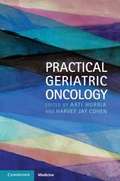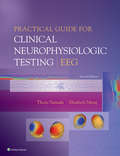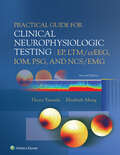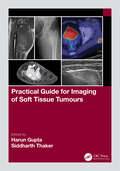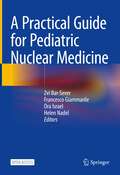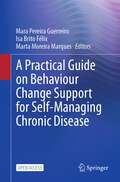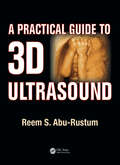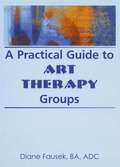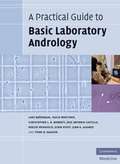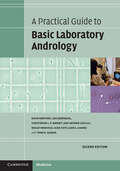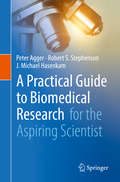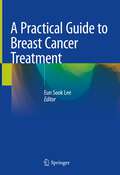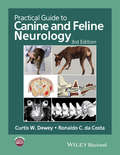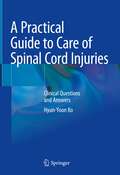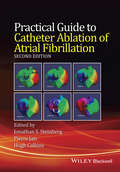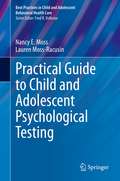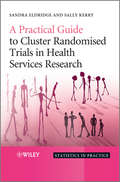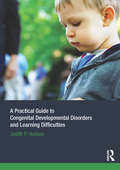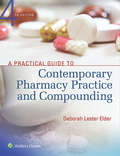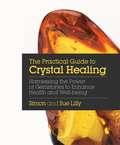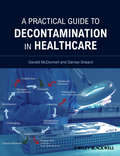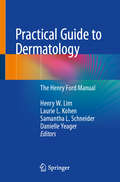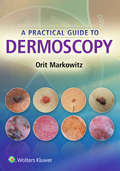- Table View
- List View
Practical Gastrointestinal Pathology: Frequently Asked Questions (Practical Anatomic Pathology)
by Hanlin L. Wang Zongming Eric ChenThis book addresses practical issues that reflect the current landscape of GI pathology practice and is organized in such a way that fits the fast-pacing daily life of practicing pathologists. It contains more than 540 questions that address difficult, prevailing and controversial issues in GI pathology that are frequently encountered in daily practice and consult service. For most questions, answers are straightforward with ample literature support. However, true diagnostic controversies and clinical dilemma cannot be easily resolved with current knowledge and available information. To such challenges, an expert approach regarding how to synthesize complicated topics and clearly communicate the thinking process is valuable to readers and can help guide clinicians making optimal treatment plans for their patients. The latter types of answers are highly enriched throughout the book. Distinct from other existing GI pathology textbooks, this book is primarily organized according to disease entities and pathological processes instead of specific organs and anatomic locations. Guided by chapter titles and listed questions, readers should be able to look up a disease or a pathological feature and find the most important and relevant diagnostic criteria and pertinent differential diagnoses. Written by experts in the field, Practical Gastrointestinal Pathology provides easy and quick access to concise, evidence-based and up-to-date information to aid accurate diagnosis and serves as a useful resource for practicing pathologists, pathology trainees and GI clinicians as well as allied health professionals who frequently deal with GI pathology.
Practical Genitourinary Pathology: Frequently Asked Questions (Practical Anatomic Pathology)
by Ming Zhou Ximing J. YangThis book serves as a practical guide and provides updates in Genitourinary (GU) Pathology. By using a “Questions and Answers” format, it addresses frequently encountered diagnostic challenges in daily practice for pathologists. Emphasis is placed on diagnosis and differential diagnosis based on morphological characteristics, clinicopathologic correlation, and interpretation of immunohistochemical and other ancillary tests. Concise answers to each question are provided by experts in the field accompanied by ample high quality illustrations and updated references. This book includes common and rare benign and malignant conditions in the GU system, covering the entire genitourinary system including the prostate, kidney, bladder, testis, urethra, ureter, penis and adrenal. It also reviews current topics, controversies and diagnostic dilemmas in diagnostic GU pathology. Practical Genitourinary Pathology serves as a quick reference for busy practicing pathologists, pathologists in training, urologists, medical students, and other physicians with questions of genitourinary conditions.
Practical Geriatric Oncology
by Arti Hurria Harvey Jay CohenThis comprehensive text provides guidelines to the care of elderly cancer patients, which is different from that of younger adults.
Practical Guide for Clinical Neurophysiologic Testing: EEG
by Thoru Yamada Elizabeth MengIdeal for technologists, neurology residents, and clinical neurophysiology fellows, Practical Guide for Clinical Neurophysiologic Testing: EEG, 2nd Edition, provides comprehensive, up-to-date guidance on electroencephalography technology and interpretation. From key foundational knowledge such as basic electronics and recording techniques, to new videos and new ACNS guidelines, this reference is a highly regarded go-to guide for using this essential neurodiagnostic tool to its fullest potential.
Practical Guide for Clinical Neurophysiologic Testing: EP, LTM/ccEEG, IOM, PSG, and NCS/EMG
by Thoru Yamada Elizabeth MengFocusing on the technical aspects of clinical neurophysiologic testing, Practical Guide for Clinical Neurophysiologic Testing: EP, LTM/ccEEG, IOM, PSG, and NCS/EMG 2nd Edition, offers comprehensive guidance on neurophysiologic testing that picks up where the companion Practical Guide for Clinical Neurophysiologic Testing: EEG ends. Dr. Thoru Yamada and Elizabeth Meng provide advanced content on evoked potentials, intraoperative monitoring, long-term EEG monitoring, epilepsy monitoring, sleep studies, and nerve conduction studies. All chapters have been updated to incorporate recent advancements and new studies and articles.
Practical Guide for Imaging of Soft Tissue Tumours
by Harun Gupta Siddharth ThakerSoft tissue tumours are extremely common although difficult to understand due to a large number of sub-types, leading to a significant increase in their imaging in the last decade. This highly illustrated practical book provides a simplified, systematic approach to imaging, reporting and diagnosing these tumours. It covers all the modalities with emphasis on ultrasound and MRI, along with the newer techniques in these modalities. This concise guide to soft tissue lesions, will help clinicians to quickly understand the spectrum of tumours and identify the appropriate imaging techniques to best serve their patients. Key Features:• Provides guidance by international experts on various types of soft tissue tumours (benign, malignant and tumour mimics), their relevant imaging features to help suggest specific or differential diagnosis and when to biopsy and when to refer to specialist centres.• Proves to be an excellent resource for general and specialist radiologists, radiology trainees, sonographers, sarcoma surgeons and oncologists for day-to-day reporting.• Discusses the importance of proper imaging and biopsy of tumors and the implications of unplanned excisions in sarcoma.
A Practical Guide for Pediatric Nuclear Medicine
by Zvi Bar-Sever Francesco Giammarile Ora Israel Helen NadelThis open access book will provide a foundation for the understanding of, and knowledge for a successful routine use of diagnostic Nuclear Medicine procedures in children through expertise and cases provided by representative busy pediatric nuclear medicine facilities. The book highlights important aspects of nuclear medicine in children and the differences between adult and pediatric practice where relevant.An introductory chapter provides general information detailing the advantages and limitations for performing nuclear medicine tests in children, as well as suggestions on how to approach and provide relevant data to the patients, their parents or next of kin. In the remaining 11 chapters, containing over 115 cases of children evaluated for various clinical indications, procedures are presented and subsequently detailed according to their clinical significance or prevalence based on the clinical experience of the contributors. The book is organized by organ systems, and also includes chapter on oncology and infection/ inflammation. Chapters are formatted to provide information regarding clinical indications, preparation including radiopharmaceutical doses and additional medications, study protocol, study interpretation, correlative imaging. Each chapter will include red flags warning and take home messages sections to emphasize important points. The case format is presented with patient history and then study report and impression.Based on practices explored by experts at the forefront of this field, the publication is directed at Nuclear Medicine physicians, radiologists, oncologists and clinicians in various pediatric specialties, medical physicists, medical technologists, radiopharmacists, laboratory medicine scientists and researchers.
A Practical Guide on Behaviour Change Support for Self-Managing Chronic Disease
by Mara Pereira Guerreiro Isa Brito Félix Marta Moreira MarquesThis open access book is a valuable resource for students in health and other professions and practicing professionals interested in supporting effective change in self-management behaviors in chronic disease, such as medication taking, physical activity and healthy eating.Developed under the auspices of the Train4Health project, funded by the Erasmus+ program of the European Union, the book contains six chapters written by international contributors from different disciplines. Chapter one introduces the competencies necessary for delivering effective behavior change support, based on an established program of work, and related learning outcomes. The four following chapters describe how these competencies can be acquired, focusing on concepts and theories, assessing self-management behaviors, implementing change strategies and person-centered communication, using a practical approach. The last chapter points out supplementary learning resources, developed as part of the Train4Health project.
A Practical Guide to 3D Ultrasound
by Reem S. Abu-RustumA Practical Guide to 3D Ultrasound was conceived with the beginner in mind. The guide summarizes the basics of 3D sonography in a concise manner and serves as a practical reference for daily practice. It is written in easy-to-read language and contains tables summarizing the step-by-step instructions for the techniques presented. Following introduc
A Practical Guide to Art Therapy Groups
by Diane SteinbachAre you in need of some variety and imagination for your art therapy repertoire? If so, this is the book for you! Diane Fausek&’s unique approaches, materials, and advice will inspire you to tap into your own well of creativity to design your own treatment plans. A Practical Guide to Art Therapy Groups lays out the ingredients and the step-by-step plans, but it&’s up to you to mix in your own caring and therapeutic skills to get the results you want.A Practical Guide to Art Therapy Groups is the only book of its kind. It gives you not only fresh ideas, but also specific directions on topic and material implementation. With the book&’s specific guidelines and practical advice, you will find planning therapeutic group sessions easier and less time-consuming. When struggling for ideas, you can turn to this book as a source for many appealing themes and issues, already organized and grouped together with compatible materials for your convenience. You will learn how to: interweave fabric techniques and collage with personal philosophies and challenges enhance sensory stimulation through collage use painting techniques to improve abstract thinking skills and the ability to find images develop collage techniques using both traditional and nontraditional materials employ nature objects that emphasize clients’own natural flaws and strengths use stencils and the individual&’s silhouette to focus thoughts and energies at self-definition and group dynamicsWithin this book, you&’ll find many successful treatment plans that have been used in long-term care settings with clients affected by Alzheimer&’s, stroke complications, geri-psychiatric conditions, and developmental disabilities. Each plan can be adapted to fit your particular setting and the needs of your clients. Whether you are a student, a counselor, an art therapist, or an activity director, A Practical Guide to Art Therapy Groups can help you provide innovative, fun, and therapeutic opportunities for your clients and open the doors to communication.
A Practical Guide to Basic Laboratory Andrology
by Lars Björndahl David Mortimer Christopher L. R. Barratt Jose Antonio Castilla Roelof Menkveld Ulrik Kvist Juan G. Alvarez Trine B. HaugenThis practical, extensively illustrated handbook covers the procedures that are undertaken in andrology and ART laboratories to analyse and assess male-factor infertility, and to prepare spermatozoa for use in assisted conception therapy. The content is presented as brief, authoritative overviews of the relevant biological background for each area, plus detailed, step-by-step descriptions of the relevant analytical procedures. Each technical section includes pertinent quality control considerations, as well as the optimum presentation of results. In addition to the comprehensive 'basic' semen analysis, incorporating careful analysis of sperm morphology, the handbook provides established techniques for the use of computer-aided sperm analysis and sperm functional assessment. Throughout the handbook the interpretation of laboratory results in the clinical context is highlighted, and safe laboratory practice is emphasized. It is an invaluable resource to all scientists and technicians who perform diagnostic testing for male-factor infertility.
A Practical Guide to Basic Laboratory Andrology
by Lars Björndahl David Mortimer Roelof Menkveld Ulrik Kvist Juan G. Alvarez Trine B. Haugen Christopher L. Barratt José Antonio CastillaThis practical, extensively illustrated handbook covers the procedures that are undertaken in andrology and ART laboratories to analyse and assess male-factor infertility, and to prepare spermatozoa for use in assisted conception therapy. The content is presented as brief, authoritative overviews of the relevant biological background for each area, plus detailed, step-by-step descriptions of the relevant analytical procedures. Each technical section includes quality control considerations and the optimum presentation of results. In addition to the comprehensive 'basic' semen analysis, incorporating careful analysis of sperm morphology, the handbook provides established techniques for the use of computer-aided sperm analysis and sperm functional assessment. The interpretation of laboratory results in the clinical context is highlighted throughout, and safe laboratory practice is emphasized. Fully revised, incorporating the new ISO TS 23162 on basic human semen analysis throughout, this is an invaluable resource to all scientists and technicians who perform diagnostic testing for male-factor infertility.
A Practical Guide to Biomedical Research
by Peter Agger Robert S. Stephenson J. Michael HasenkamThis book advises and supports novice researchers in taking their first steps into the world of scientific research. Through practical tips and tricks presented in a clear, concise and step-wise manner, the book describes the entire research process from idea to publication. It also gives the reader insight into the vast opportunities a research career can provide. The books target demographic is aspiring researchers within the biomedical professions, be it medical students, young doctors, nurses, engineers, physiotherapists etc. The book will help aspirational inexperienced researchers turn their intentions into actions, providing crucial guidance for successful entry into the field of biomedical research.
A Practical Guide to Breast Cancer Treatment
by Eun Sook LeeThis book presents expert viewpoints on the diverse situations faced by practitioners in their daily practice when caring for patients with breast cancer, with focuses on the patient-centered treatment process. It provides the entire process of different patient cases from patient history, radiologic examination, pathologic results, surgical outcome and medical treatment.The aim is to equip readers with all the knowledge required in order to implement appropriate case-by-case approaches in the real world, where circumstances frequently differ from the typical or straightforward scenarios depicted in textbooks and articles.The book will serve as a practice guideline for novices less familiar with the field, but it will also be a valuable aid for more experienced practitioners and will even offer assistance in research planning. Furthermore, the book will help some patient to infer their own treatment by using similar cases as a model.
Practical Guide to Canine and Feline Neurology
by Ronaldo C. da Costa Curtis W. DeweyNow in full color, Practical Guide to Canine and Feline Neurology, Third Edition provides a fully updated new edition of the most complete resource on managing neurology cases in small animal practice, with video clips on a companion website. *Provides comprehensive information for diagnosing and treating neurological conditions *Printed in full color for the first time, with 400 new or improved images throughout *Offers new chapters on differential diagnosis, magnetic resonance imaging, and movement disorders *Retains the logical structure and easy-to-follow outline format of the previous editions *Includes access to video clips of specific disorders and a how-to video demonstrating the neurologic assessment online and a link to a digital canine brain atlas at www.wiley.com/go/dewey/neurology Now in full color, Practical Guide to Canine and Feline Neurology, Third Edition provides a fully updated new edition of the most complete resource on managing neurology cases in small animal practice, with video clips on a companion website. *Provides comprehensive information for diagnosing and treating neurological conditions *Printed in full color for the first time, with 400 new or improved images throughout *Offers new chapters on differential diagnosis, magnetic resonance imaging, and movement disorders *Retains the logical structure and easy-to-follow outline format of the previous editions *Includes access to video clips of specific disorders and a how-to video demonstrating the neurologic assessment online and a link to a digital canine brain atlas at www.wiley.com/go/dewey/neurology
A Practical Guide to Care of Spinal Cord Injuries: Clinical Questions and Answers
by Hyun-Yoon KoThis book, structured as a collection of questions and answers commonly encountered in the care of individuals with spinal cord injuries, aims to facilitate easy access to clinical and practical information for those involved in their treatment. The author, known for their expertise in spinal cord injuries, has developed this book to offer concise knowledge specifically tailored for clinicians and related healthcare professionals engaged in the care of spinal cord injuries. Unlike his previous works, this book goes beyond the traditional format and incorporates more concise and clinically-oriented questions and answers. Drawing from the author's practical experience and his role in training resident physicians in spinal cord medicine at the University Hospital, the content of this book addresses practical and clinical considerations. To enhance clinical understanding, the book extensively employs figures and tables throughout its comprehensive coverage of various aspects of spinal cord medicine. The author aspires for this book to serve as a valuable clinical companion, providing supplemental practical guidance for daily practice in the field of spinal cord injuries.
Practical Guide to Catheter Ablation of Atrial Fibrillation
by Hugh Calkins Jonathan S. Steinberg Pierre JaisNow in its second edition, this practical guide offers clear-headed guidance to the successful application of catheter ablation for atrial fibrillation. This book concentrates on clinically-relevant information that providers can put to immediate use caring for patients. Takes a clear-headed practical approach to ablation of atrial fibrillation - long on actionable, clinically-relevant guidance, succinct and to-the-point on the theory behind the procedure Edited by three leading, internationally-known electrophysiologists with extensive experience in ablation for atrial fibrillation Written by international team of experts reflecting global best practices from centers with considerable experience in the use of catheter ablation Format designed to serve the needs of electrophysiologists regardless of experience, electrophysiology fellows, electrophysiology nurses and lab technical staff Covers hot topics such as new noninvasive imaging techniques, the treatment of challenging left atrial flutters, options for persistent atrial fibrillation and when a redo ablation is needed; and novel application of ablation targeting the autonomic nervous system
Practical Guide to Child and Adolescent Psychological Testing (Best Practices in Child and Adolescent Behavioral Health Care)
by Nancy E. Moss Lauren Moss-RacusinThis book explains the psychological assessment process and reviews the origins of psychological testing, referral and testing processes, and prominent psychological assessment instruments. Most important, this book details how to evaluate testing data and use them to understand an individual’s needs and to inform interventions and treatments.This book addresses specific domains of psychological assessment, including:· Intelligence and academic achievement.· Speech-language and visual-motor abilities.· Memory, attention/concentration, and executive functioning.· Behavioral and social-emotional functioning.· Developmental status.Practical Guide to Child and Adolescent Psychological Testing is an essential resource for clinicians, primary care providers, and other practitioners as well as researchers, professors, and graduate students in the fields of child, school, and developmental psychology, pediatrics and social work, child and adolescent psychiatry, primary care medicine, and related disciplines.
A Practical Guide to Cluster Randomised Trials in Health Services Research
by Sandra Eldridge Sally KerryCluster randomised trials are trials in which groups (or clusters) of individuals are randomly allocated to different forms of treatment. In health care, these trials often compare different ways of managing a disease or promoting healthy living, in contrast to conventional randomised trials which randomise individuals to different treatments, classically comparing new drugs with a placebo. They are increasingly common in health services research. This book addresses the statistical, practical, and ethical issues arising from allocating groups of individuals, or clusters, to different interventions. Key features: Guides readers through the stages of conducting a trial, from recruitment to reporting.Presents a wide range of examples with particular emphasis on trials in health services research and primary care, with both principles and techniques explained.Topics are specifically presented in the order in which investigators think about issues when they are designing a trial.Combines information on the latest developments in the field together with a practical guide to the design and implementation of cluster randomised trials.Explains principles and techniques through numerous examples including many from the authors own experience.Includes a wide range of references for those who wish to read further. This book is intended as a practical guide, written for researchers from the health professions including doctors, psychologists, and allied health professionals, as well as statisticians involved in the design, execution, analysis and reporting of cluster randomised trials. Those with a more general interest will find the plentiful examples illuminating.
A Practical Guide to Congenital Developmental Disorders and Learning Difficulties
by Judith P. HudsonTo give children with congenital developmental conditions that manifest special learning needs and specific disabilities their best chance to succeed, early identification and appropriate interventions and support, is necessary. This text highlights what to look for when there are concerns about a child’s development. Practical and accessible, it is divided into three sections: Part 1 looks at the theory and policy context, discussing the social model of disability, the responsibility of health, social care and education services to the child and family and the role of reviews and assessment in recognising developmental disorders. Part 2 provides a reference guide to atypical developmental conditions and disorders. For each condition, aetiology, prominent theories and research, profile of features – including triggers and behaviours, diagnostic assessment procedures and appropriate interventions are given and links made to sources of further information and support. Part 3 explores practical issues how to work sensitively and effectively with children and their families, looking at the psychological implications of diagnosis, and how to plan, promote, deliver and evaluate multi-agency support. Designed to support professionals working within a multi-modal, collaborative approach to assessment and intervention processes, it is suitable for health visitors, allied health therapists, nurses, teachers and social care practitioners. It is also a useful reference for students in these areas learning about child development and includes critical reading exercises; online searching tasks; self-assessment questions; reflective activities and document analysis prompts.
A Practical Guide to Contemporary Pharmacy Practice and Compounding
by Deborah LesterA Practical Guide to Contemporary Pharmacy Practice and Compounding is your hands-on, step-by-step guide to receiving and filling prescription drug orders as well as a comprehensive look at the preparation of sterile and non-sterile extemporaneously compounded preparations.
The Practical Guide to Crystal Healing: Harnessing the Power of Gemstones to Enhance Health and Well-being
by Simon Lilly Sue LillyThe ultimate handbook on the use of crystals for healing, with expert guidance on how to achieve results – this is a great addition to every crystal enthusiast’s library and a must-have for beginners.Crystals have been used as a complementary therapy to combat both physical and emotional ailments for centuries; their unique vibrational resonances able to restore balance to the body’s energy systems and enhance spiritual, mental and physical wellbeing.Alongside guidance on the most important crystals to use for specific illnesses and situations, whether it be insomnia, migraines, depression or the upheaval of moving house, crystal therapy experts Simon and Sue Lilly provide practical tips on how to use these precious stones to restore overall health and further spiritual development. Using clear, step-by-step instructions, The Practical Guide to Crystal Healing will teach you how to use crystals to: • heal the body • balance the mind • cope with change • feed the spirit • and live in harmony. Packed with tried-and-tested layouts for healing, guided visualizations and meditations, and an illustrated repertory of key crystals, this is an essential book for beginners and experienced crystal healers alike.
A Practical Guide to Decontamination in Healthcare
by Gerald Mcdonnell Denise Sheard Diploma NursingPrevention is the first line of defence in the fight against infection. As antibiotics and other antimicrobials encounter increasing reports of microbial resistance, the field of decontamination science is undergoing a major revival. A Practical Guide to Decontamination in Healthcare is a comprehensive training manual, providing practical guidance on all aspects of decontamination including: microbiology and infection control; regulations and standards; containment, transportation, handling, cleaning, disinfection and sterilization of patient used devices; surgical instrumentation; endoscopes; and quality management systems. Written by highly experienced professionals, A Practical Guide to Decontaminationin Healthcare comprises a systematic review of decontamination methods, with uses and advantages outlined for each. Up-to-date regulations, standards and guidelines are incorporated throughout, to better equip healthcare professionals with the information they need to meet the technical and operational challenges of medical decontamination. A Practical Guide to Decontaminationin Healthcare is an important new volume on state-of-the-art decontamination processes and a key reference source for all healthcare professionals working in infectious diseases, infection control/prevention and decontamination services.
Practical Guide to Dermatology: The Henry Ford Manual
by Henry W. Lim Samantha L. Schneider Laurie L. Kohen Danielle YeagerThis practical manual provides a real-world educationally focused resource. It enables the reader to gain a good understanding of a range of skin diseases, their differential diagnosis and various medical and/or surgical treatment options. Topics covered include general dermatology, oncodermatology, drugs, phototherapy, pigmentary disorders, skin of color, inpatient dermatology and pediatric dermatology. Emphasis is placed on concise, practical points that one can use in clinic, with informative pearls to reinforce the key messages in each chapter. Practical Guide to Dermatology: The Henry Ford Manual systematically describes a broad range of practical concepts, diagnostic and treatment techniques involving various dermatological disciplines. It represents a valuable reference guide for practising and trainee dermatologists alike.
A Practical Guide to Dermoscopy
by Orit MarkowitzDermoscopy has revolutionized the evaluation of pigmented lesions, but pattern recognition alone isn’t always sufficient to make a diagnosis. A Practical Guide to Dermoscopy helps you use Dr. Orit Markowitz’s unique, “color wheel” approach to solve difficult diagnostic challenges, particularly when it comes to distinguishing between malignant and benign conditions, and thus expedite effective treatment.
